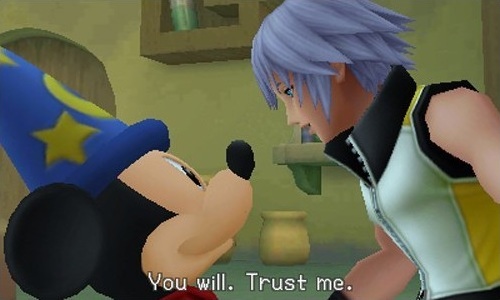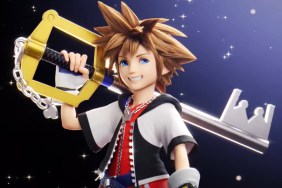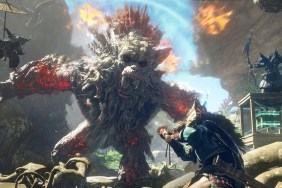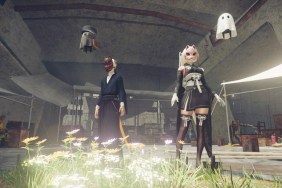Going the distance.
Whenever I see an article or post about the delays on Final Fantasy Versus XIII, I shake my head and think about Kingdom Hearts. The director for both is Tetsuya Nomura. But he's not just the director for the first Kingdom Hearts, but he's also the director for all of them, including the handheld and mobile games. If we count both Kingdom Hearts Coded and Re:Coded as separate games, Nomura's directed five Kingdom Hearts games since FF Versus XIII was announced. It's not hard to do the math to see why maybe the other game has been a long time coming. There's also no reason to push it, since Kingdom Hearts isn't hurting Square Enix much at all.
Kingdom Hearts: Dream Drop Distance is crazy. I don't mean "crazy" like other handheld Kingdom Hearts games, which are there to feed new information slowly enough about the main storyline to keep fans hooked into every release (and inspire Sora/Riku slash fiction). I mean "crazy" in that the gameplay is nuts.
Instead of drawing out an introduction of the game's 7+ gameplay mechanics over an extended period of time, the game crams them one after another into the first area you visit. And these are core mechanics, not counting the Drop mini-game that takes the place of Gummi ships, the Flick Rush Tournament, or the individual environmental mini-games that change from world to world. It's as if Square Enix executives sat around a table and listed every different gameplay system they liked and just decided to put them all in the game—no one said no.
Well, this seems to have been a good decision, because the game is awesome. You play as both Sora and Riku, alternating from one to the other as you fight in alternative versions of the same worlds, which are actually the dreams of worlds that are sleeping in the darkness (or something, it got kind of hard to follow). The shift from one to the other is determined by a meter that slowly empties on the bottom fo the screen, and then the game automatically drops from one character to the other. Magic and special attacks are compiled in a deck with limited spaces from the start screen, and "flowmotion" attacks allow you to bounce off walls and dropkick enemies. Donald and Goofy have been replaced this time around by Spirit Friends, whom you create from the remains of enemies (Dream Eaters) you dispatch in battle.
The Spirit Friends are a huge part of the game, as they are part Pokémon, part Nintendogs, part mini-game collection. You can have three in your party at any time and two of them fight with you, with one in reserve that can be switched out during battle, and they provide a number of different support or combat actions. You can power them up outside of battle and raise their affinity with Sora or Riku by playing mini-games you find or buy from moogles, feeding them food, or petting them in the Augmented Reality environment created using the 3DS 3D camera. And you'll want to level them up, because that's how Sora and Riku receive special attacks. But the mini-games are fast and mostly enjoyable, and the Spirit Friends look especially cute responding to belly rubs or head nudges.
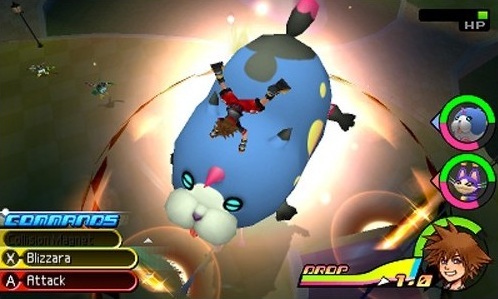
Somehow the game, with its many different systems, just works. When regular attacks aren't effective, you can run through your magic, special attacks, and items from the deck, or pull off a flowmotion attack by bouncing off a wall or spinning around a lampost. Or, when the link gauge fills up, link up directly with one or both of your active Spirit Friends to deal massive damage to enemies in the area. These linked attacks can be a highlight of the game, since they can produce wildly different types of attacks, based on the Spirit Friend's type. It's actually fun to level up your Spirit Friends, unlocking better stronger attacks for Sora and Riku.
On story, Dream Drop Distance feels like it's angling directly towards the next game being a "number" sequel to the series. The story takes place at the end of the series, goes to great lengths to summarize and tie together every Kingdom Hearts game into a cohesive narrative, and introduces plot elements that are pushing towards a much larger confrontation. Other handheld games in the series (358/2 Days, Birth By Sleep) have filled in the backstories of certain characters or taken the story to copies of the worlds (Chain of Memories, Re:Coded) with just enough material outside of the backstory or rehash to push the overarching story a little bit forward. Dream Drop Distance does both of these, but with more story.
Master Yen Cid, the sorcerer from The Sorcerer's Apprentice, sends Sora and Riku to unlock the hearts of seven sleeping kingdoms as a test for them to become Keyblade Masters, to ready themselves for the coming war/battle/thing. I'm going to stop there, because if I get into much more of the backstory, it'll start to sound like a five volume fantasy novel series written in the 1980s. The level design and story pick up much more in the second half of the game, when it stops rehashing Tron: Legacy, The Hunchback of Notre Dame, and Pinocchio (yet again). Parts of the story even feel clearly inspired by Inception, which is weird to write about a Kingdom Hearts game.
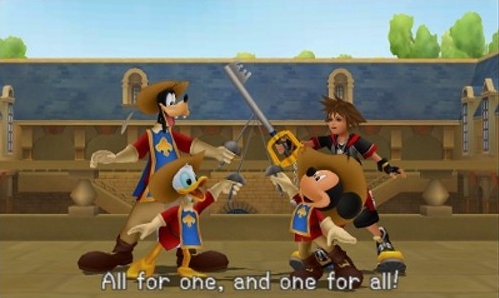
Dream Drop Distance is a full-sized game with over 30 hours of content and more if you decide to unlock every ability. Considering the Flick Rush tournament mini-game, level-specific challenges that can be found on the map, the number of Spirit Friends you can create, and a New Game+ option (you get to retain your existing Spirit Friends when you restart), you could easily play for much much longer.
It's not a perfect game, though. It has some of the flaws that seem to inhabit most games in the series—an iffy camera, boss battles sometimes being much more difficult than gameplay up to that point, and shaky pathfinding that occasionally doesn't give a clear idea where to go on a map with similar-looking environments.
That said, Dream Drop Distance looks amazing. In fact, it may be the best-looking game in the series, with strongly utilized 3D and some of the highest production value on the 3DS to date. For those who haven't played the series, it handily sums up the highlights from each game and has a glossary of terms that adequately explain the prior games, making this a good jumping-off point for anyone who wants to get into (or back into) the series before they release their next game on consoles. Bottom line: This is a great game on a system that needs more great games.
-
Looks <i>amazing</i>
-
Has glossary/recaps
-
Strong gameplay
-
Manages multiple systems
-
Story is a little hard to follow
-
Camera issues
-
Still moves the story forward
-
Spirit Friends are cute and fun
